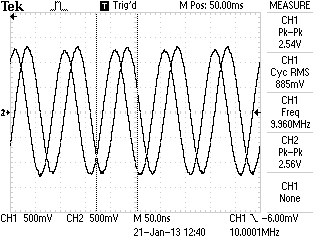Yes, a belated Happy New Year greetings! It’s hard to believe that 2013 is already well under way. I figured it was about time to give you a quick update on what’s going on in the shack right now.
First up is the discrete component grabber receiver for 14.141 MHz that I prototyped to be paired with the OpenBeaconMini project. The receiver itself consists of a roughly 2 kHz wide crystal filter on the front end, feeding into a single-balanced diode ring mixer, which drives an AF amp using 2N4401 and 2N4403 transistors. Because I’m not able to put up a proper outdoor antenna for the grabber right now, I decided to put the VE7BPO cascode active antenna on it instead. It seems to work well, but I don’t know for sure because there are basically no signals on this part of the band. I intended to use my Raspberry Pi with the receiver as a grabber, but I had no luck getting either LOPORA or QRSSVD to work properly and reliably. It may just be asking too much of the poor beast. So I’m going to try to appropriate another PC in order to get the grabber receiver QRV so that on-air testing of OpenBeaconMini can begin in earnest.

Next, I wanted to give you a very brief overview of my most recent purchase for the lab: a Rigol DS1022U arbitrary waveform generator. As far as I can tell, this appears to be pretty much the same as the DS1022A model that is sold in the US. But being a typical ham, I wanted to save a few dollars, so I purchased it off of eBay from seller who says he is an authorized Rigol dealer.

The DG1022[U|A] has two channels that can output a sine wave up to 25 MHz in 1 mHz (as in millihertz) steps. It can also provide square, ramp, pulse, noise, and arbitrary waveforms at lesser frequencies. It can modulate the waveform in a variety of ways, including AM, FM, PM, PWM, and FSK. It can, of course, also do sweeps of various parameters. The output amplitude into 50 Ω ranges from 10 Vpp on Channel 1 or 3 Vpp on Channel 2 down to 2 mVpp on both channels (or -50 dBm). The shielding on this AWG seems to be excellent. Using my HP 355C/355D attenuator combo, I can get a signal down to about -140 dBm (disclaimer: not a scientific measurement, made using my ear as a detector and listening on my IC-718). The dual outputs makes it very useful for a variety of two-tone receiver measurements, one of the big reasons driving my purchase. The Channel 2 output also doubles as a 200 MHz frequency counter input. Paired with the USB connectivity of the device (it seems to enumerate as a usbtmc device), that will be extremely handy for measuring oscillator drift. The DG1022 can also link the two channels together and give them a specific phase difference, as you can see below. This will make it very handy as a I/Q LO when I want to experiment with phasing and SDR rigs.
So far, I’ve been very pleased with my purchase. I don’t feel like I’ve had it or used it long enough to give you a full review, but I thought that this preview would at least be a bit helpful for those thinking about using it. One of my goals for the new year is to do a much better job of characterizing everything that I build. Since I intend to start selling transceivers in the near future, it’s doubly-important that I can make accurate measurements of my products so that I can properly state their specifications. To this end, I’ve decided to sell off a bunch of my unused or replaceable test equipment (please take a look at the for sale posting) in order to finance the new, calibrated test gear. Next up on my purchase list is a Rigol DSA815TG spectrum analyzer (just reviewed favorably in the February 2013 QST), but that’s going to require the sale of everything on that page!
Finally, I’ve got the CC1 prototype PCBs on their way from Seeed Studio right now. It looks like they just cleared customs in the US, so hopefully they will be in my hands in the next few days. With any luck, I’ll have the first one built by the weekend and will be well on the way to a new beta test. I’ll put up a quick post to show off the PCBs, and when the first prototype unit is completed. Stay tuned!

I’ve been looking into these Rigol function generators too; there’s a rather old (not-so-stable) generator in my shack right now.
I’m happy with the DSA815TG spectrum analyzer, which I bought several months ago. I can’t read QST, it would have been nice to see what they’re thinking about it.
You have some interesting project here, it’s always a pleasure to see a blog with such content.
Hans / PD0AC
Thanks Hans! I’m still very pleased with my purchase of the DG1022U and I think it would be a good replacement for an older signal generator. I’m convinced on the DSA815TG, I just need to find the money to purchase it. 🙂